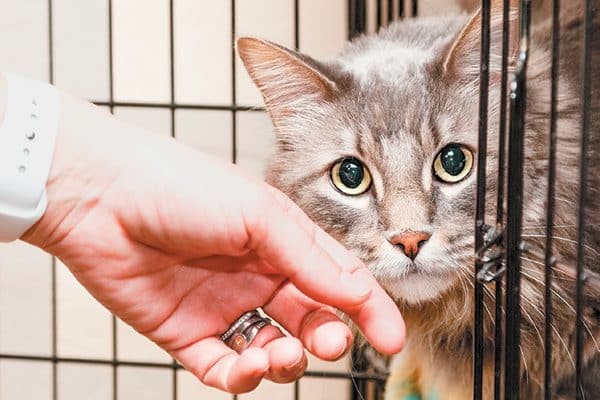Cat scratch fever — officially called cat scratch disease (CSD) — is a bacterial infection caused by Bartonella henselae bacteria. It’s also a zoonotic disease — a disease passed between animals and people. Cat scratch fever is preventable if you understand feline behavior and ensure your pets are protected from fleas.
“Cats can become infected with this bacteria as a result of a flea bite and, less commonly, from fights with other infected cats or a feline blood transfusion,” explains Christina Nelson, MD, MPH, medical officer with the Centers for Disease Control and Prevention’s (CDC’s) Division of Vector-borne Diseases.
“While some cats become ill, most simply carry the bacteria in their blood without getting sick. Some studies have found the Bartonella bacteria in the blood of up to one third of healthy cats, particularly kittens. And, in the United States, the illness is most common in children under 15 years old,” she says.
What cat scratch fever looks like

For cats who do become sick, the illness usually consists of a fever for two to three days, with the cat recovering on his own. Symptoms requiring veterinary care include fever, vomiting, lethargy, red eyes, swollen lymph nodes or decreased appetite.
For humans, the most common symptoms include a lowgrade fever, enlarged, tender lymph nodes that develop one to three weeks after exposure and a scab or pustule at the scratch site. According to the CDC, rarely manifestations such as severe muscle pain, eye infections or encephalitis may also occur.
How to prevent cat scratch fever
Even in the most harmonious households, situations arise when a usually laid-back cat scratches and even bites his favorite people. The best away to avoid being bitten or scratched — and also cat scratch fever — is to better understand cat behavior.
Behaviorist Pam Johnson-Bennett, author of Cat Wise, and best known for her signature “think-like-a-cat” motto, says that cats don’t like physical confrontations, whether it’s with people or inter-species because they understandably don’t want to get injured.
“That’s why they use posturing to hopefully dissuade opponents from engaging in battle,” Pam explains. “When a cat scratches or bites another cat, it typically means all other warnings, such as posturing or vocalizations have failed to work, and the cat had no other alternative.
“The circumstances surrounding the need to scratch or bite are usually based on a perceived threat. A cat may feel his territory is in danger or he may be trying to gain more territory, a queen may be protecting her kittens, or a cat may be having to compete over resource availability. Intact male cats may also battle for the opportunity to mate with an available female. The bottom line is that biting and scratching means the cat feels there is no alternative,” Pam says.
Cat fights and cat scratches and bites
Further, Pam warns that cat parents should never get in the middle of a cat fight in an attempt to break it up because you can be seriously injured — by being bitten or scratched or both!
“The safest way to break up a fight is to distract the cats by making a sudden noise such as banging a pot so they will scatter in two different directions,” she says. “If a loud noise doesn’t stop the fight you can throw a towel over them and that will usually cause them to separate. They should then be kept in separate rooms so they can each take the time to calm down and get back to normal behavior. However, never try to carry an agitated cat to a separate room.”
7 tricks to avoid cat fights

The key to preventing cat fights in a multicat household is to figure out the underlying cause why the cats dislike each other so you can make behavioral and environmental adjustments. Pam suggests the following:
- Take a good look at how the environment has been set up because the cats may feel threatened due to limited resource availability. (Litter box, food, water, etc.)
- Make certain that one cat does not have to cross another cat’s area in order to access the litter box.
- Create vertical territory, such as a cat tree or window perches as well as hiding areas, so the cats can have distance from each other.
- Look at the litter box setup to ensure that one cat isn’t getting ambushed when there. Provide uncovered litter boxes that are placed throughout the house so no one feels trapped.
- Provide the cats with fun things to do in the form of interactive play as well as solo playtime to release energy and anxiety.
- The use of puzzle feeders is a great way to keep cats busy and engaged during the day so they don’t become bored and turn on each other. Look at the environment from a cat’s point of view because there are usually several ways you can tweak things to create a more secure, interesting and cat-friendly territory.
- Rule out medical issues, as pain may be causing one cat to be aggressive.
Avert the scratch
Pam also points out that a cat may scratch a person when he gets overstimulated during play. “It typically happens when people use their fingers as toys or are holding a small toy,” she says.
“It’s important to never use your hands as toys because it sends a mixed message that biting flesh is acceptable. The safest way to play with your cat is to use an interactive toy, which is based on a fishing pole design. This toy puts a safe distance between your fingers and the cat’s teeth. It also allows the cat to fully enjoy the experience and be the mighty hunter.”
“A cat may also scratch when overstimulated from petting,” Pam warns. “In most cases, the cat has already given multiple signals that the petting session has crossed over from pleasurable to prickly. When signals such as meowing, skin twitching and growling have failed to stop your behavior, a scratch or bite is a last resort.”
Stop the bacteria from a cat scratch

According to veterinarian Jeff Glass, of Stonecreek Animal Hospital in Irvine, California, because cat scratch fever is associated with bacteria and spread by contact with an infected cat via a bite, scratch or even exposure to fleas, it’s important to apply flea products approved by a veterinarian to feline (and canine) members of the household.
“Keeping cats indoors decreases their contact with fleas and prevents them from fighting with stray or potentially infected cats. Also, keep their nails trimmed,” he adds. If you do get scratched or bitten, Dr. Nelson stresses the importance of washing the area right away with soap and running water. Seek medical attention if a fever, redness around the wound, a headache, poor appetite, fatigue or swollen, painful lymph nodes develop.
“And never allow cats to lick your open wounds,” she advises. And the last word comes from Pam. “The best thing we can do is be respectful — most cats require a personal space and need to feel you aren’t a threat. This is important to teach to children. Never pick up or pet an unfamiliar cat. The politest thing to do is to extend your index finger so the cat can sniff it. Don’t stick your finger in his face, just extend it so he can make the decision of whether to engage or not.”
Thumbnail: Photography ©sjallenphotography | Thinkstock.
Ziggy and Tory “work” as feline muses for Sandy Robins, an award-winning multimedia pet lifestyle expert, author and pet industry personality. They like to disrupt the workflow by playing fetch with wand toys and directing food operations in the kitchen. Learn more about Sandy at sandyrobinsonline.com.
Editor’s note: This article appeared in Catster magazine. Have you seen the new Catster print magazine in stores? Or in the waiting room of your vet’s office? Subscribe now to get Catster magazine delivered straight to you!








